Business Finance Report: Analysis of Profit, Cash Flow, and Budgeting
VerifiedAdded on 2022/12/26
|11
|3380
|95
Report
AI Summary
This comprehensive business finance report delves into critical financial concepts and their practical applications. The report begins by defining profit and cash flow, highlighting their differences, and explaining the significance of working capital, receivables, payables, and inventory. It explores how effective management impacts a company's financial results, using a case study of Trends Ltd. The report includes recommendations for optimizing working capital management. Part B focuses on the preparation of a monthly cash budget for Thorne Estates, analyzing cash flow projections, and providing insights to improve financial planning. The report provides a detailed analysis of the financial data, offering valuable insights for financial decision-making and operational efficiency.
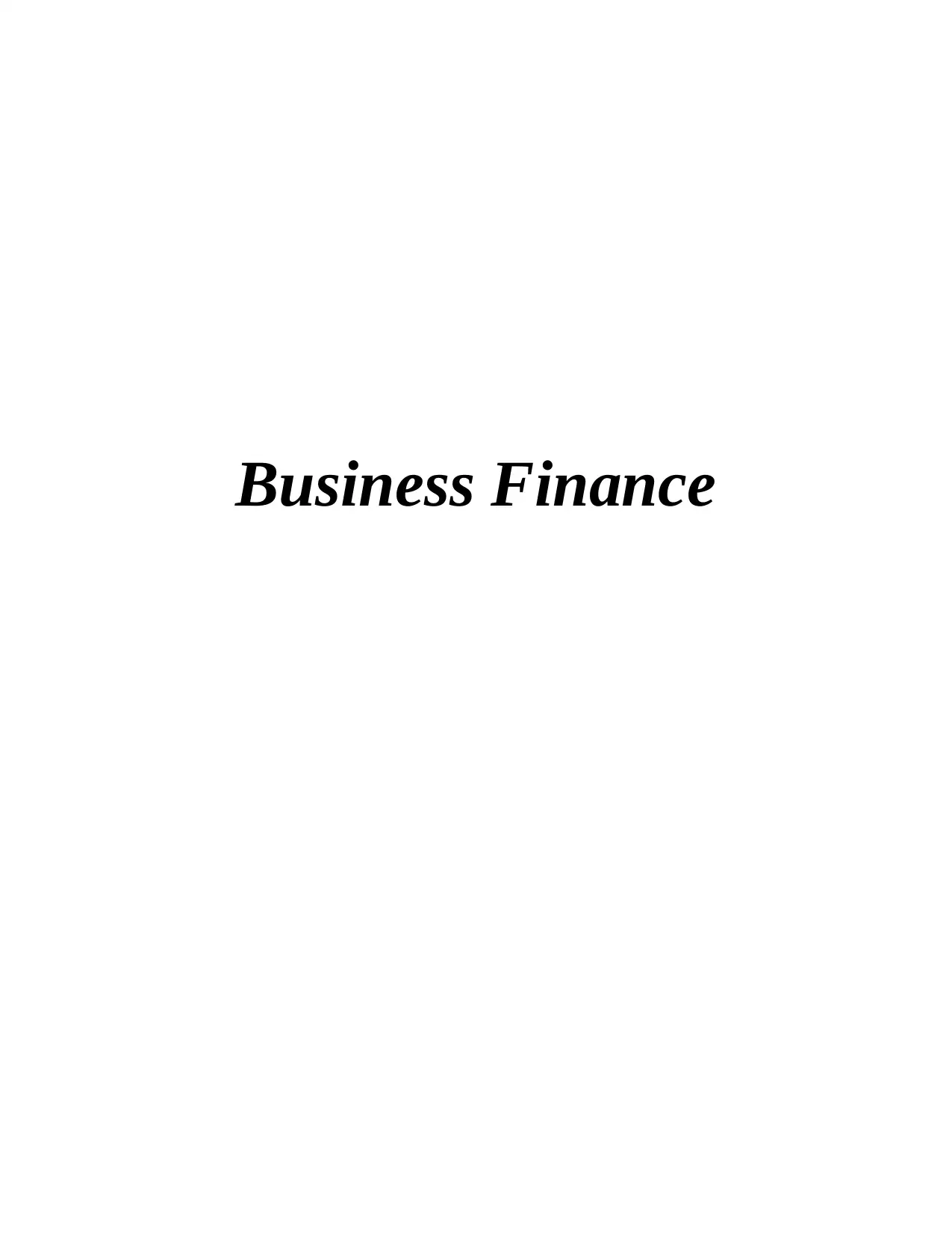
Business Finance
Paraphrase This Document
Need a fresh take? Get an instant paraphrase of this document with our AI Paraphraser
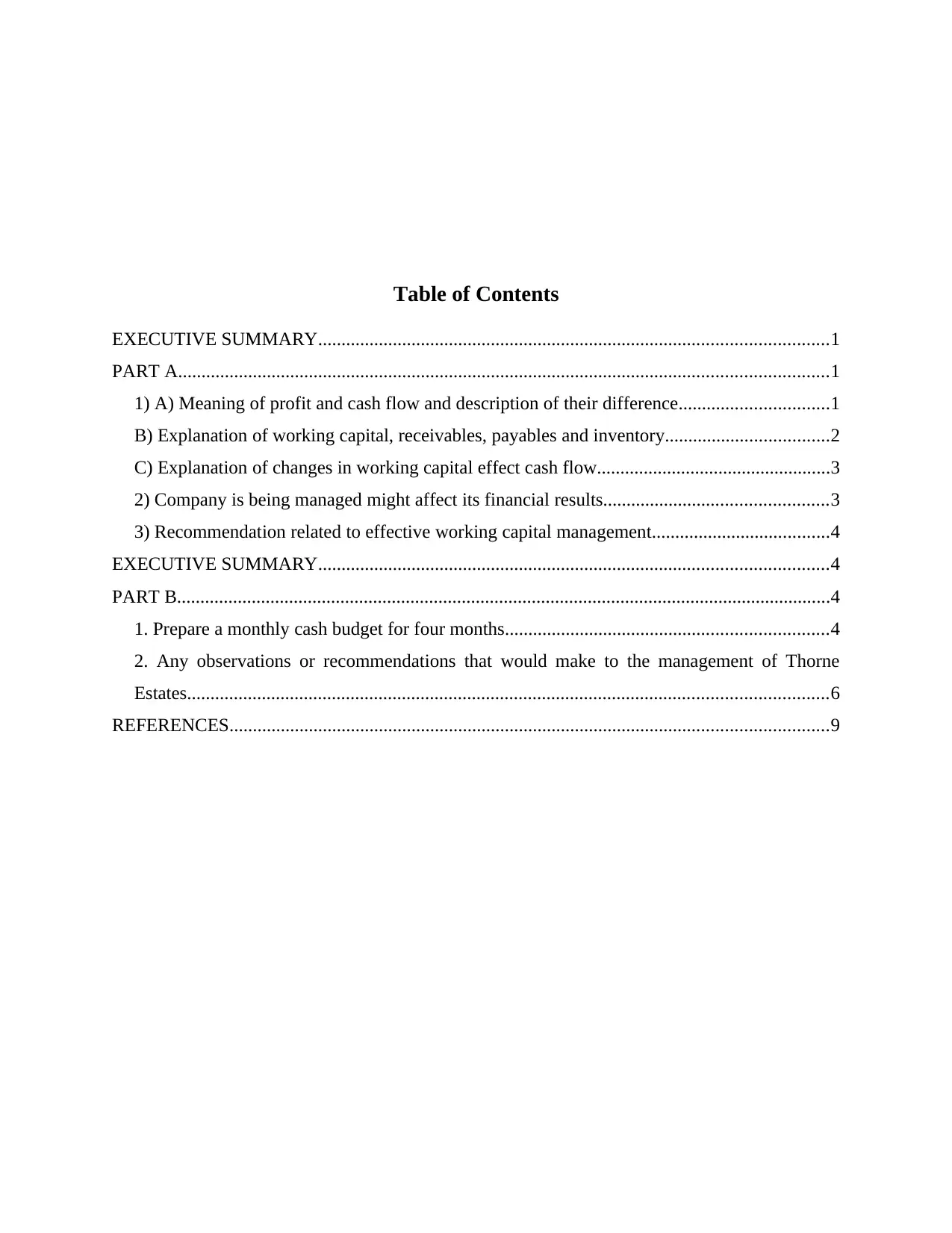
Table of Contents
EXECUTIVE SUMMARY.............................................................................................................1
PART A...........................................................................................................................................1
1) A) Meaning of profit and cash flow and description of their difference................................1
B) Explanation of working capital, receivables, payables and inventory...................................2
C) Explanation of changes in working capital effect cash flow..................................................3
2) Company is being managed might affect its financial results................................................3
3) Recommendation related to effective working capital management......................................4
EXECUTIVE SUMMARY.............................................................................................................4
PART B............................................................................................................................................4
1. Prepare a monthly cash budget for four months.....................................................................4
2. Any observations or recommendations that would make to the management of Thorne
Estates.........................................................................................................................................6
REFERENCES................................................................................................................................9
EXECUTIVE SUMMARY.............................................................................................................1
PART A...........................................................................................................................................1
1) A) Meaning of profit and cash flow and description of their difference................................1
B) Explanation of working capital, receivables, payables and inventory...................................2
C) Explanation of changes in working capital effect cash flow..................................................3
2) Company is being managed might affect its financial results................................................3
3) Recommendation related to effective working capital management......................................4
EXECUTIVE SUMMARY.............................................................................................................4
PART B............................................................................................................................................4
1. Prepare a monthly cash budget for four months.....................................................................4
2. Any observations or recommendations that would make to the management of Thorne
Estates.........................................................................................................................................6
REFERENCES................................................................................................................................9
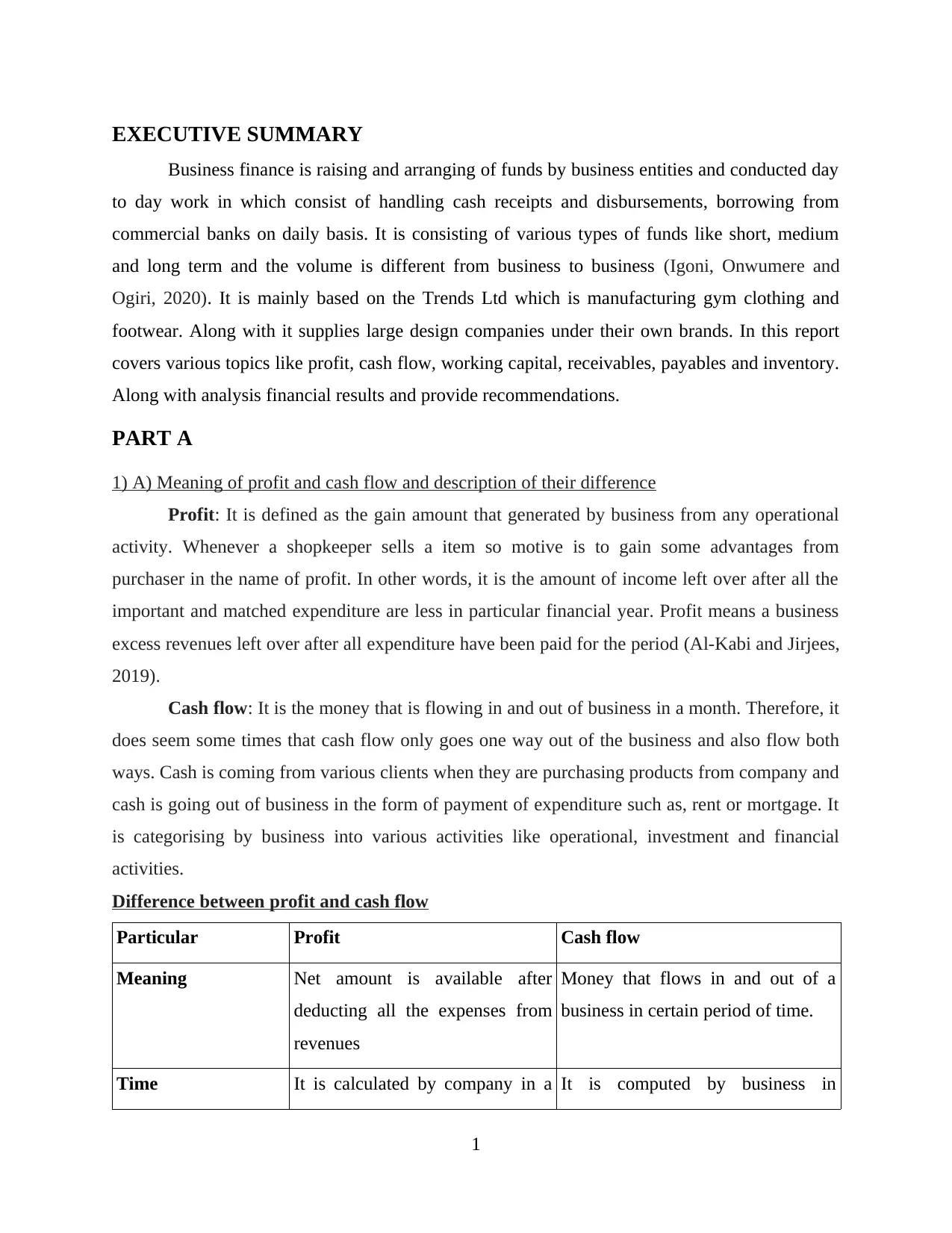
EXECUTIVE SUMMARY
Business finance is raising and arranging of funds by business entities and conducted day
to day work in which consist of handling cash receipts and disbursements, borrowing from
commercial banks on daily basis. It is consisting of various types of funds like short, medium
and long term and the volume is different from business to business (Igoni, Onwumere and
Ogiri, 2020). It is mainly based on the Trends Ltd which is manufacturing gym clothing and
footwear. Along with it supplies large design companies under their own brands. In this report
covers various topics like profit, cash flow, working capital, receivables, payables and inventory.
Along with analysis financial results and provide recommendations.
PART A
1) A) Meaning of profit and cash flow and description of their difference
Profit: It is defined as the gain amount that generated by business from any operational
activity. Whenever a shopkeeper sells a item so motive is to gain some advantages from
purchaser in the name of profit. In other words, it is the amount of income left over after all the
important and matched expenditure are less in particular financial year. Profit means a business
excess revenues left over after all expenditure have been paid for the period (Al-Kabi and Jirjees,
2019).
Cash flow: It is the money that is flowing in and out of business in a month. Therefore, it
does seem some times that cash flow only goes one way out of the business and also flow both
ways. Cash is coming from various clients when they are purchasing products from company and
cash is going out of business in the form of payment of expenditure such as, rent or mortgage. It
is categorising by business into various activities like operational, investment and financial
activities.
Difference between profit and cash flow
Particular Profit Cash flow
Meaning Net amount is available after
deducting all the expenses from
revenues
Money that flows in and out of a
business in certain period of time.
Time It is calculated by company in a It is computed by business in
1
Business finance is raising and arranging of funds by business entities and conducted day
to day work in which consist of handling cash receipts and disbursements, borrowing from
commercial banks on daily basis. It is consisting of various types of funds like short, medium
and long term and the volume is different from business to business (Igoni, Onwumere and
Ogiri, 2020). It is mainly based on the Trends Ltd which is manufacturing gym clothing and
footwear. Along with it supplies large design companies under their own brands. In this report
covers various topics like profit, cash flow, working capital, receivables, payables and inventory.
Along with analysis financial results and provide recommendations.
PART A
1) A) Meaning of profit and cash flow and description of their difference
Profit: It is defined as the gain amount that generated by business from any operational
activity. Whenever a shopkeeper sells a item so motive is to gain some advantages from
purchaser in the name of profit. In other words, it is the amount of income left over after all the
important and matched expenditure are less in particular financial year. Profit means a business
excess revenues left over after all expenditure have been paid for the period (Al-Kabi and Jirjees,
2019).
Cash flow: It is the money that is flowing in and out of business in a month. Therefore, it
does seem some times that cash flow only goes one way out of the business and also flow both
ways. Cash is coming from various clients when they are purchasing products from company and
cash is going out of business in the form of payment of expenditure such as, rent or mortgage. It
is categorising by business into various activities like operational, investment and financial
activities.
Difference between profit and cash flow
Particular Profit Cash flow
Meaning Net amount is available after
deducting all the expenses from
revenues
Money that flows in and out of a
business in certain period of time.
Time It is calculated by company in a It is computed by business in
1
⊘ This is a preview!⊘
Do you want full access?
Subscribe today to unlock all pages.

Trusted by 1+ million students worldwide
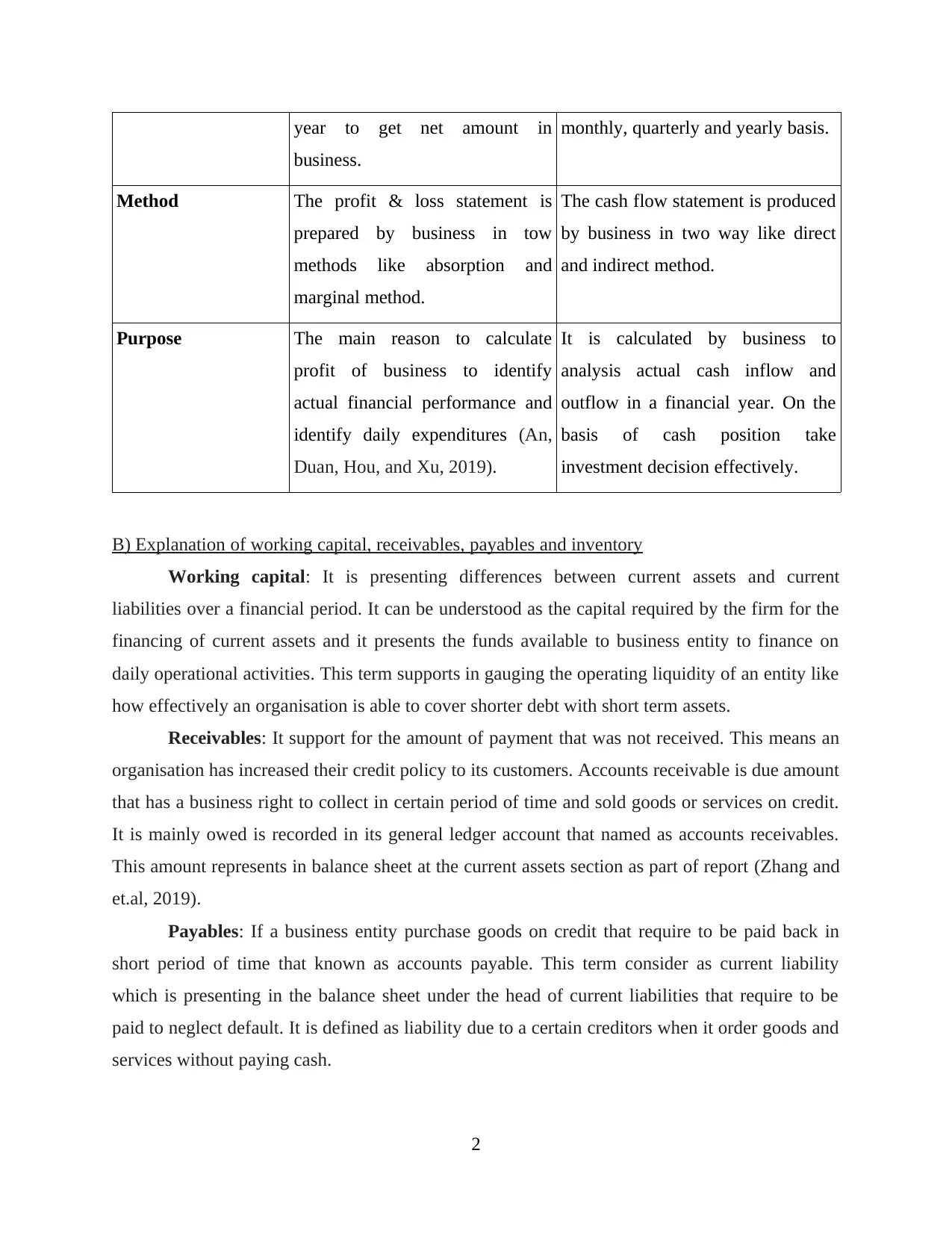
year to get net amount in
business.
monthly, quarterly and yearly basis.
Method The profit & loss statement is
prepared by business in tow
methods like absorption and
marginal method.
The cash flow statement is produced
by business in two way like direct
and indirect method.
Purpose The main reason to calculate
profit of business to identify
actual financial performance and
identify daily expenditures (An,
Duan, Hou, and Xu, 2019).
It is calculated by business to
analysis actual cash inflow and
outflow in a financial year. On the
basis of cash position take
investment decision effectively.
B) Explanation of working capital, receivables, payables and inventory
Working capital: It is presenting differences between current assets and current
liabilities over a financial period. It can be understood as the capital required by the firm for the
financing of current assets and it presents the funds available to business entity to finance on
daily operational activities. This term supports in gauging the operating liquidity of an entity like
how effectively an organisation is able to cover shorter debt with short term assets.
Receivables: It support for the amount of payment that was not received. This means an
organisation has increased their credit policy to its customers. Accounts receivable is due amount
that has a business right to collect in certain period of time and sold goods or services on credit.
It is mainly owed is recorded in its general ledger account that named as accounts receivables.
This amount represents in balance sheet at the current assets section as part of report (Zhang and
et.al, 2019).
Payables: If a business entity purchase goods on credit that require to be paid back in
short period of time that known as accounts payable. This term consider as current liability
which is presenting in the balance sheet under the head of current liabilities that require to be
paid to neglect default. It is defined as liability due to a certain creditors when it order goods and
services without paying cash.
2
business.
monthly, quarterly and yearly basis.
Method The profit & loss statement is
prepared by business in tow
methods like absorption and
marginal method.
The cash flow statement is produced
by business in two way like direct
and indirect method.
Purpose The main reason to calculate
profit of business to identify
actual financial performance and
identify daily expenditures (An,
Duan, Hou, and Xu, 2019).
It is calculated by business to
analysis actual cash inflow and
outflow in a financial year. On the
basis of cash position take
investment decision effectively.
B) Explanation of working capital, receivables, payables and inventory
Working capital: It is presenting differences between current assets and current
liabilities over a financial period. It can be understood as the capital required by the firm for the
financing of current assets and it presents the funds available to business entity to finance on
daily operational activities. This term supports in gauging the operating liquidity of an entity like
how effectively an organisation is able to cover shorter debt with short term assets.
Receivables: It support for the amount of payment that was not received. This means an
organisation has increased their credit policy to its customers. Accounts receivable is due amount
that has a business right to collect in certain period of time and sold goods or services on credit.
It is mainly owed is recorded in its general ledger account that named as accounts receivables.
This amount represents in balance sheet at the current assets section as part of report (Zhang and
et.al, 2019).
Payables: If a business entity purchase goods on credit that require to be paid back in
short period of time that known as accounts payable. This term consider as current liability
which is presenting in the balance sheet under the head of current liabilities that require to be
paid to neglect default. It is defined as liability due to a certain creditors when it order goods and
services without paying cash.
2
Paraphrase This Document
Need a fresh take? Get an instant paraphrase of this document with our AI Paraphraser
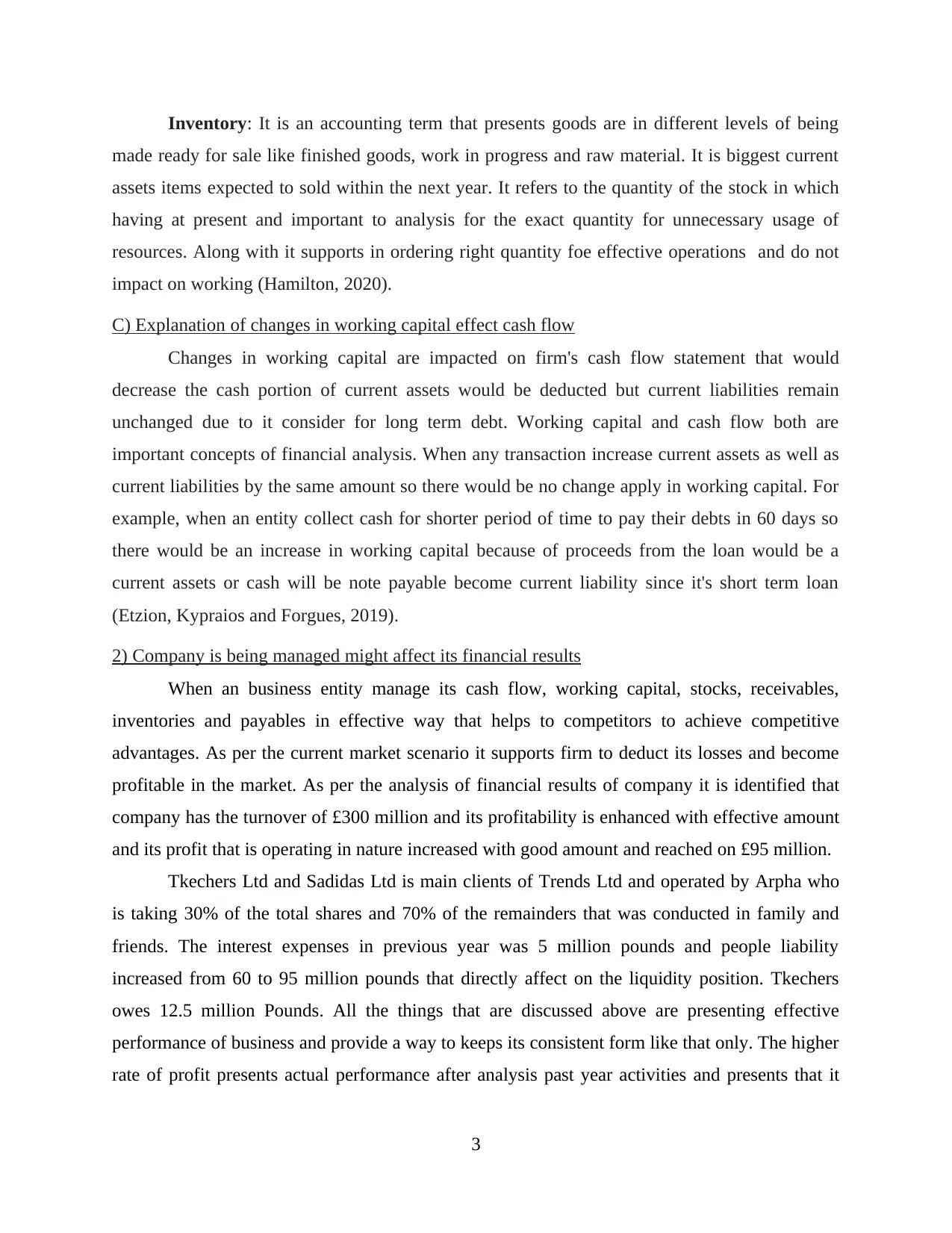
Inventory: It is an accounting term that presents goods are in different levels of being
made ready for sale like finished goods, work in progress and raw material. It is biggest current
assets items expected to sold within the next year. It refers to the quantity of the stock in which
having at present and important to analysis for the exact quantity for unnecessary usage of
resources. Along with it supports in ordering right quantity foe effective operations and do not
impact on working (Hamilton, 2020).
C) Explanation of changes in working capital effect cash flow
Changes in working capital are impacted on firm's cash flow statement that would
decrease the cash portion of current assets would be deducted but current liabilities remain
unchanged due to it consider for long term debt. Working capital and cash flow both are
important concepts of financial analysis. When any transaction increase current assets as well as
current liabilities by the same amount so there would be no change apply in working capital. For
example, when an entity collect cash for shorter period of time to pay their debts in 60 days so
there would be an increase in working capital because of proceeds from the loan would be a
current assets or cash will be note payable become current liability since it's short term loan
(Etzion, Kypraios and Forgues, 2019).
2) Company is being managed might affect its financial results
When an business entity manage its cash flow, working capital, stocks, receivables,
inventories and payables in effective way that helps to competitors to achieve competitive
advantages. As per the current market scenario it supports firm to deduct its losses and become
profitable in the market. As per the analysis of financial results of company it is identified that
company has the turnover of £300 million and its profitability is enhanced with effective amount
and its profit that is operating in nature increased with good amount and reached on £95 million.
Tkechers Ltd and Sadidas Ltd is main clients of Trends Ltd and operated by Arpha who
is taking 30% of the total shares and 70% of the remainders that was conducted in family and
friends. The interest expenses in previous year was 5 million pounds and people liability
increased from 60 to 95 million pounds that directly affect on the liquidity position. Tkechers
owes 12.5 million Pounds. All the things that are discussed above are presenting effective
performance of business and provide a way to keeps its consistent form like that only. The higher
rate of profit presents actual performance after analysis past year activities and presents that it
3
made ready for sale like finished goods, work in progress and raw material. It is biggest current
assets items expected to sold within the next year. It refers to the quantity of the stock in which
having at present and important to analysis for the exact quantity for unnecessary usage of
resources. Along with it supports in ordering right quantity foe effective operations and do not
impact on working (Hamilton, 2020).
C) Explanation of changes in working capital effect cash flow
Changes in working capital are impacted on firm's cash flow statement that would
decrease the cash portion of current assets would be deducted but current liabilities remain
unchanged due to it consider for long term debt. Working capital and cash flow both are
important concepts of financial analysis. When any transaction increase current assets as well as
current liabilities by the same amount so there would be no change apply in working capital. For
example, when an entity collect cash for shorter period of time to pay their debts in 60 days so
there would be an increase in working capital because of proceeds from the loan would be a
current assets or cash will be note payable become current liability since it's short term loan
(Etzion, Kypraios and Forgues, 2019).
2) Company is being managed might affect its financial results
When an business entity manage its cash flow, working capital, stocks, receivables,
inventories and payables in effective way that helps to competitors to achieve competitive
advantages. As per the current market scenario it supports firm to deduct its losses and become
profitable in the market. As per the analysis of financial results of company it is identified that
company has the turnover of £300 million and its profitability is enhanced with effective amount
and its profit that is operating in nature increased with good amount and reached on £95 million.
Tkechers Ltd and Sadidas Ltd is main clients of Trends Ltd and operated by Arpha who
is taking 30% of the total shares and 70% of the remainders that was conducted in family and
friends. The interest expenses in previous year was 5 million pounds and people liability
increased from 60 to 95 million pounds that directly affect on the liquidity position. Tkechers
owes 12.5 million Pounds. All the things that are discussed above are presenting effective
performance of business and provide a way to keeps its consistent form like that only. The higher
rate of profit presents actual performance after analysis past year activities and presents that it
3
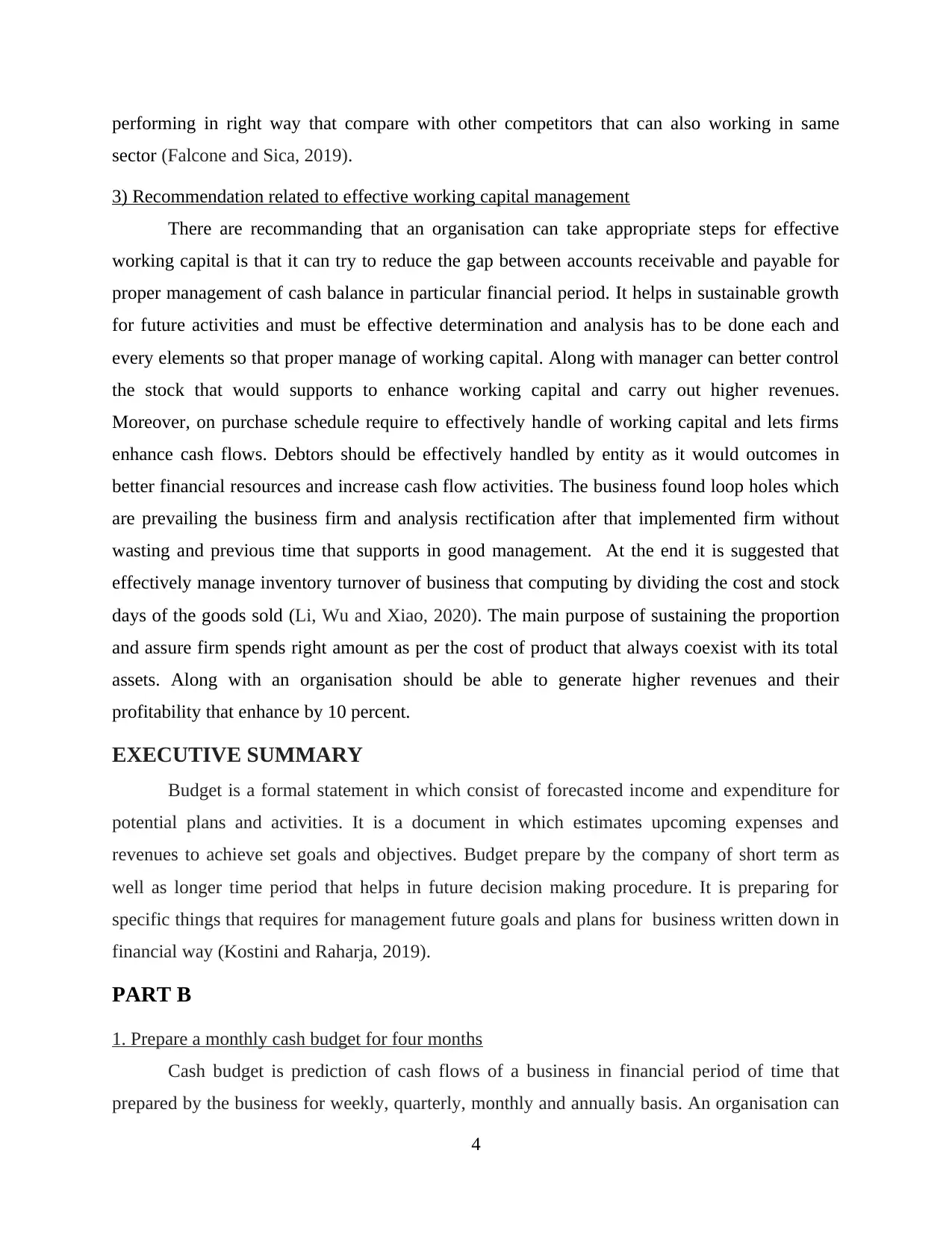
performing in right way that compare with other competitors that can also working in same
sector (Falcone and Sica, 2019).
3) Recommendation related to effective working capital management
There are recommanding that an organisation can take appropriate steps for effective
working capital is that it can try to reduce the gap between accounts receivable and payable for
proper management of cash balance in particular financial period. It helps in sustainable growth
for future activities and must be effective determination and analysis has to be done each and
every elements so that proper manage of working capital. Along with manager can better control
the stock that would supports to enhance working capital and carry out higher revenues.
Moreover, on purchase schedule require to effectively handle of working capital and lets firms
enhance cash flows. Debtors should be effectively handled by entity as it would outcomes in
better financial resources and increase cash flow activities. The business found loop holes which
are prevailing the business firm and analysis rectification after that implemented firm without
wasting and previous time that supports in good management. At the end it is suggested that
effectively manage inventory turnover of business that computing by dividing the cost and stock
days of the goods sold (Li, Wu and Xiao, 2020). The main purpose of sustaining the proportion
and assure firm spends right amount as per the cost of product that always coexist with its total
assets. Along with an organisation should be able to generate higher revenues and their
profitability that enhance by 10 percent.
EXECUTIVE SUMMARY
Budget is a formal statement in which consist of forecasted income and expenditure for
potential plans and activities. It is a document in which estimates upcoming expenses and
revenues to achieve set goals and objectives. Budget prepare by the company of short term as
well as longer time period that helps in future decision making procedure. It is preparing for
specific things that requires for management future goals and plans for business written down in
financial way (Kostini and Raharja, 2019).
PART B
1. Prepare a monthly cash budget for four months
Cash budget is prediction of cash flows of a business in financial period of time that
prepared by the business for weekly, quarterly, monthly and annually basis. An organisation can
4
sector (Falcone and Sica, 2019).
3) Recommendation related to effective working capital management
There are recommanding that an organisation can take appropriate steps for effective
working capital is that it can try to reduce the gap between accounts receivable and payable for
proper management of cash balance in particular financial period. It helps in sustainable growth
for future activities and must be effective determination and analysis has to be done each and
every elements so that proper manage of working capital. Along with manager can better control
the stock that would supports to enhance working capital and carry out higher revenues.
Moreover, on purchase schedule require to effectively handle of working capital and lets firms
enhance cash flows. Debtors should be effectively handled by entity as it would outcomes in
better financial resources and increase cash flow activities. The business found loop holes which
are prevailing the business firm and analysis rectification after that implemented firm without
wasting and previous time that supports in good management. At the end it is suggested that
effectively manage inventory turnover of business that computing by dividing the cost and stock
days of the goods sold (Li, Wu and Xiao, 2020). The main purpose of sustaining the proportion
and assure firm spends right amount as per the cost of product that always coexist with its total
assets. Along with an organisation should be able to generate higher revenues and their
profitability that enhance by 10 percent.
EXECUTIVE SUMMARY
Budget is a formal statement in which consist of forecasted income and expenditure for
potential plans and activities. It is a document in which estimates upcoming expenses and
revenues to achieve set goals and objectives. Budget prepare by the company of short term as
well as longer time period that helps in future decision making procedure. It is preparing for
specific things that requires for management future goals and plans for business written down in
financial way (Kostini and Raharja, 2019).
PART B
1. Prepare a monthly cash budget for four months
Cash budget is prediction of cash flows of a business in financial period of time that
prepared by the business for weekly, quarterly, monthly and annually basis. An organisation can
4
⊘ This is a preview!⊘
Do you want full access?
Subscribe today to unlock all pages.

Trusted by 1+ million students worldwide
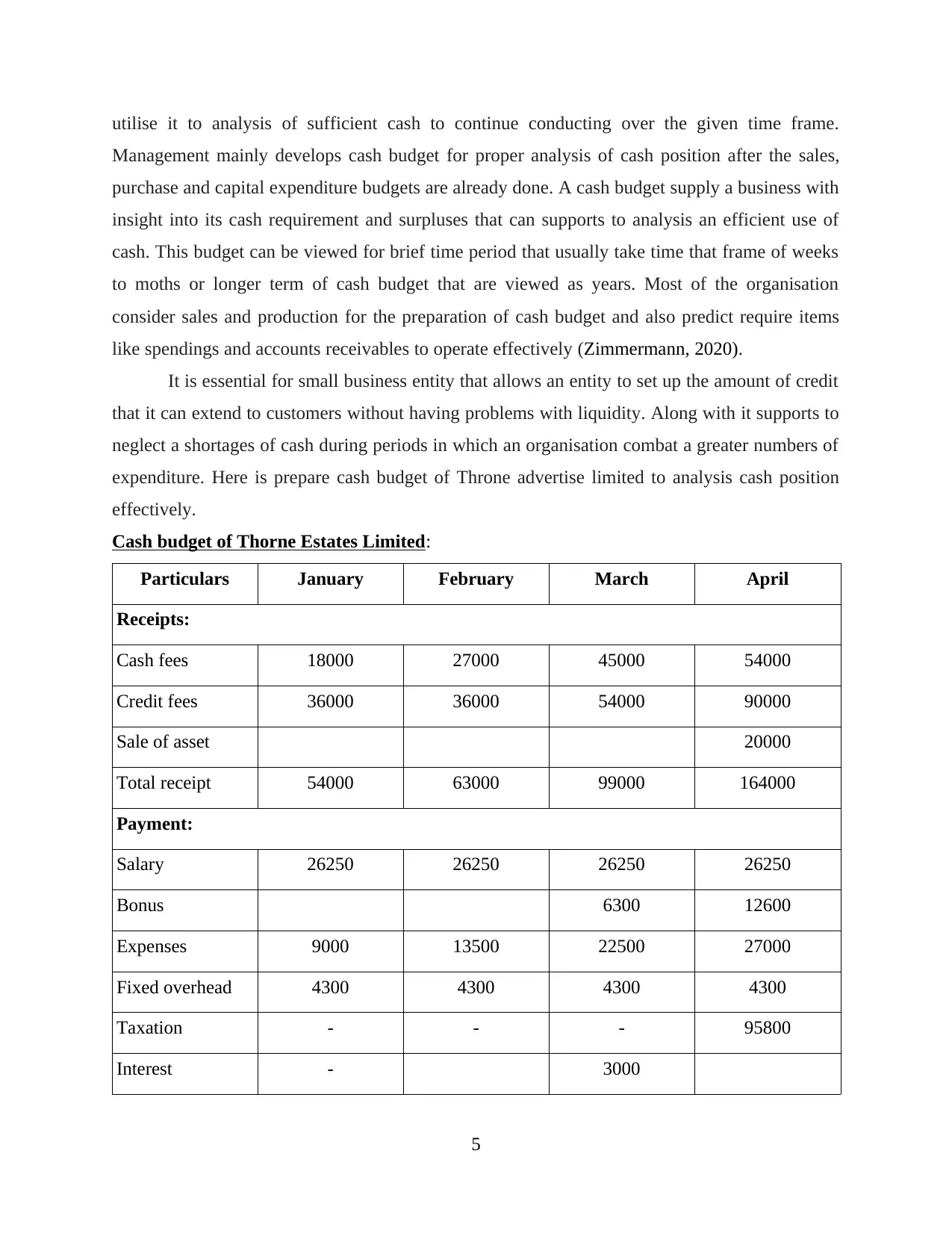
utilise it to analysis of sufficient cash to continue conducting over the given time frame.
Management mainly develops cash budget for proper analysis of cash position after the sales,
purchase and capital expenditure budgets are already done. A cash budget supply a business with
insight into its cash requirement and surpluses that can supports to analysis an efficient use of
cash. This budget can be viewed for brief time period that usually take time that frame of weeks
to moths or longer term of cash budget that are viewed as years. Most of the organisation
consider sales and production for the preparation of cash budget and also predict require items
like spendings and accounts receivables to operate effectively (Zimmermann, 2020).
It is essential for small business entity that allows an entity to set up the amount of credit
that it can extend to customers without having problems with liquidity. Along with it supports to
neglect a shortages of cash during periods in which an organisation combat a greater numbers of
expenditure. Here is prepare cash budget of Throne advertise limited to analysis cash position
effectively.
Cash budget of Thorne Estates Limited:
Particulars January February March April
Receipts:
Cash fees 18000 27000 45000 54000
Credit fees 36000 36000 54000 90000
Sale of asset 20000
Total receipt 54000 63000 99000 164000
Payment:
Salary 26250 26250 26250 26250
Bonus 6300 12600
Expenses 9000 13500 22500 27000
Fixed overhead 4300 4300 4300 4300
Taxation - - - 95800
Interest - 3000
5
Management mainly develops cash budget for proper analysis of cash position after the sales,
purchase and capital expenditure budgets are already done. A cash budget supply a business with
insight into its cash requirement and surpluses that can supports to analysis an efficient use of
cash. This budget can be viewed for brief time period that usually take time that frame of weeks
to moths or longer term of cash budget that are viewed as years. Most of the organisation
consider sales and production for the preparation of cash budget and also predict require items
like spendings and accounts receivables to operate effectively (Zimmermann, 2020).
It is essential for small business entity that allows an entity to set up the amount of credit
that it can extend to customers without having problems with liquidity. Along with it supports to
neglect a shortages of cash during periods in which an organisation combat a greater numbers of
expenditure. Here is prepare cash budget of Throne advertise limited to analysis cash position
effectively.
Cash budget of Thorne Estates Limited:
Particulars January February March April
Receipts:
Cash fees 18000 27000 45000 54000
Credit fees 36000 36000 54000 90000
Sale of asset 20000
Total receipt 54000 63000 99000 164000
Payment:
Salary 26250 26250 26250 26250
Bonus 6300 12600
Expenses 9000 13500 22500 27000
Fixed overhead 4300 4300 4300 4300
Taxation - - - 95800
Interest - 3000
5
Paraphrase This Document
Need a fresh take? Get an instant paraphrase of this document with our AI Paraphraser
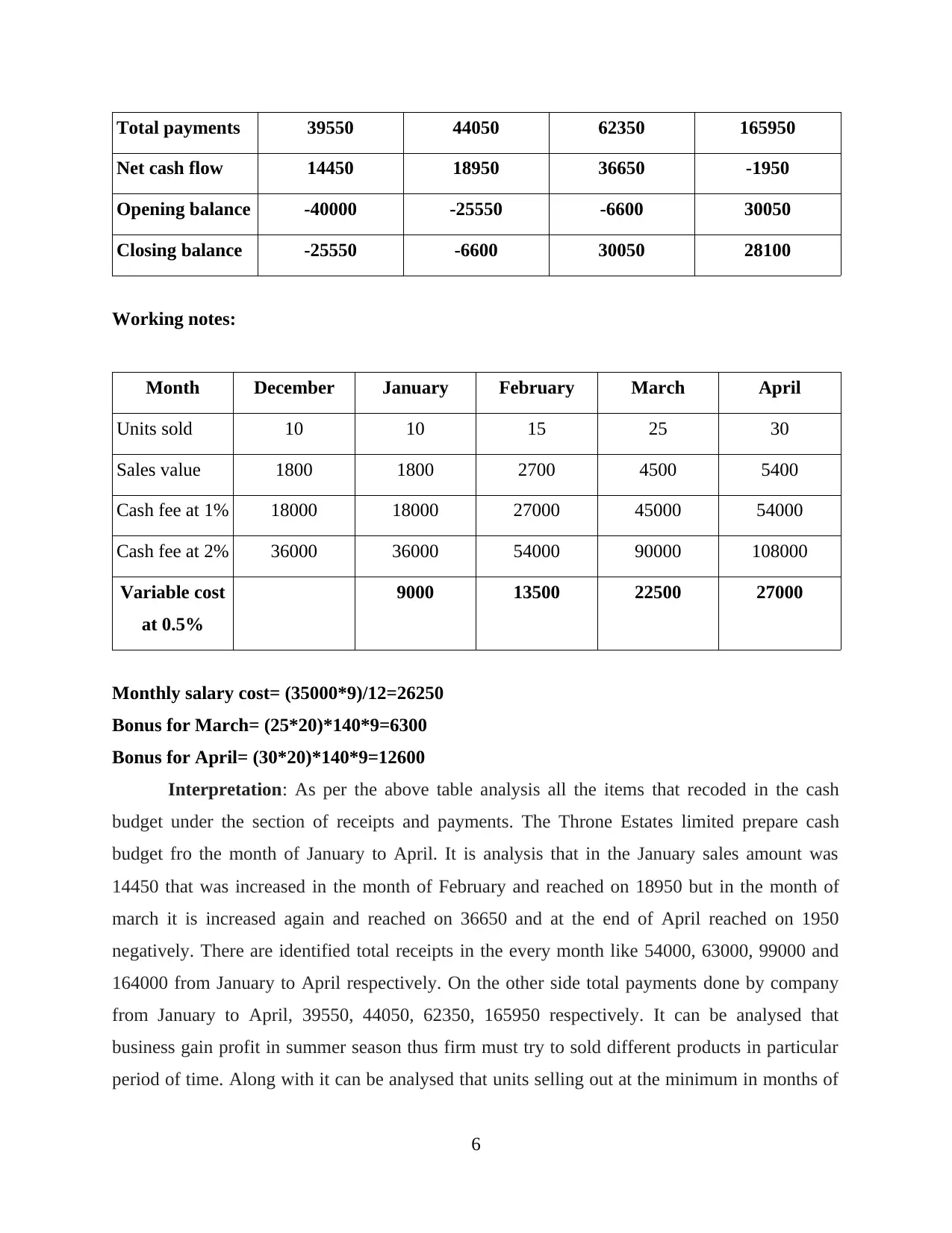
Total payments 39550 44050 62350 165950
Net cash flow 14450 18950 36650 -1950
Opening balance -40000 -25550 -6600 30050
Closing balance -25550 -6600 30050 28100
Working notes:
Month December January February March April
Units sold 10 10 15 25 30
Sales value 1800 1800 2700 4500 5400
Cash fee at 1% 18000 18000 27000 45000 54000
Cash fee at 2% 36000 36000 54000 90000 108000
Variable cost
at 0.5%
9000 13500 22500 27000
Monthly salary cost= (35000*9)/12=26250
Bonus for March= (25*20)*140*9=6300
Bonus for April= (30*20)*140*9=12600
Interpretation: As per the above table analysis all the items that recoded in the cash
budget under the section of receipts and payments. The Throne Estates limited prepare cash
budget fro the month of January to April. It is analysis that in the January sales amount was
14450 that was increased in the month of February and reached on 18950 but in the month of
march it is increased again and reached on 36650 and at the end of April reached on 1950
negatively. There are identified total receipts in the every month like 54000, 63000, 99000 and
164000 from January to April respectively. On the other side total payments done by company
from January to April, 39550, 44050, 62350, 165950 respectively. It can be analysed that
business gain profit in summer season thus firm must try to sold different products in particular
period of time. Along with it can be analysed that units selling out at the minimum in months of
6
Net cash flow 14450 18950 36650 -1950
Opening balance -40000 -25550 -6600 30050
Closing balance -25550 -6600 30050 28100
Working notes:
Month December January February March April
Units sold 10 10 15 25 30
Sales value 1800 1800 2700 4500 5400
Cash fee at 1% 18000 18000 27000 45000 54000
Cash fee at 2% 36000 36000 54000 90000 108000
Variable cost
at 0.5%
9000 13500 22500 27000
Monthly salary cost= (35000*9)/12=26250
Bonus for March= (25*20)*140*9=6300
Bonus for April= (30*20)*140*9=12600
Interpretation: As per the above table analysis all the items that recoded in the cash
budget under the section of receipts and payments. The Throne Estates limited prepare cash
budget fro the month of January to April. It is analysis that in the January sales amount was
14450 that was increased in the month of February and reached on 18950 but in the month of
march it is increased again and reached on 36650 and at the end of April reached on 1950
negatively. There are identified total receipts in the every month like 54000, 63000, 99000 and
164000 from January to April respectively. On the other side total payments done by company
from January to April, 39550, 44050, 62350, 165950 respectively. It can be analysed that
business gain profit in summer season thus firm must try to sold different products in particular
period of time. Along with it can be analysed that units selling out at the minimum in months of
6
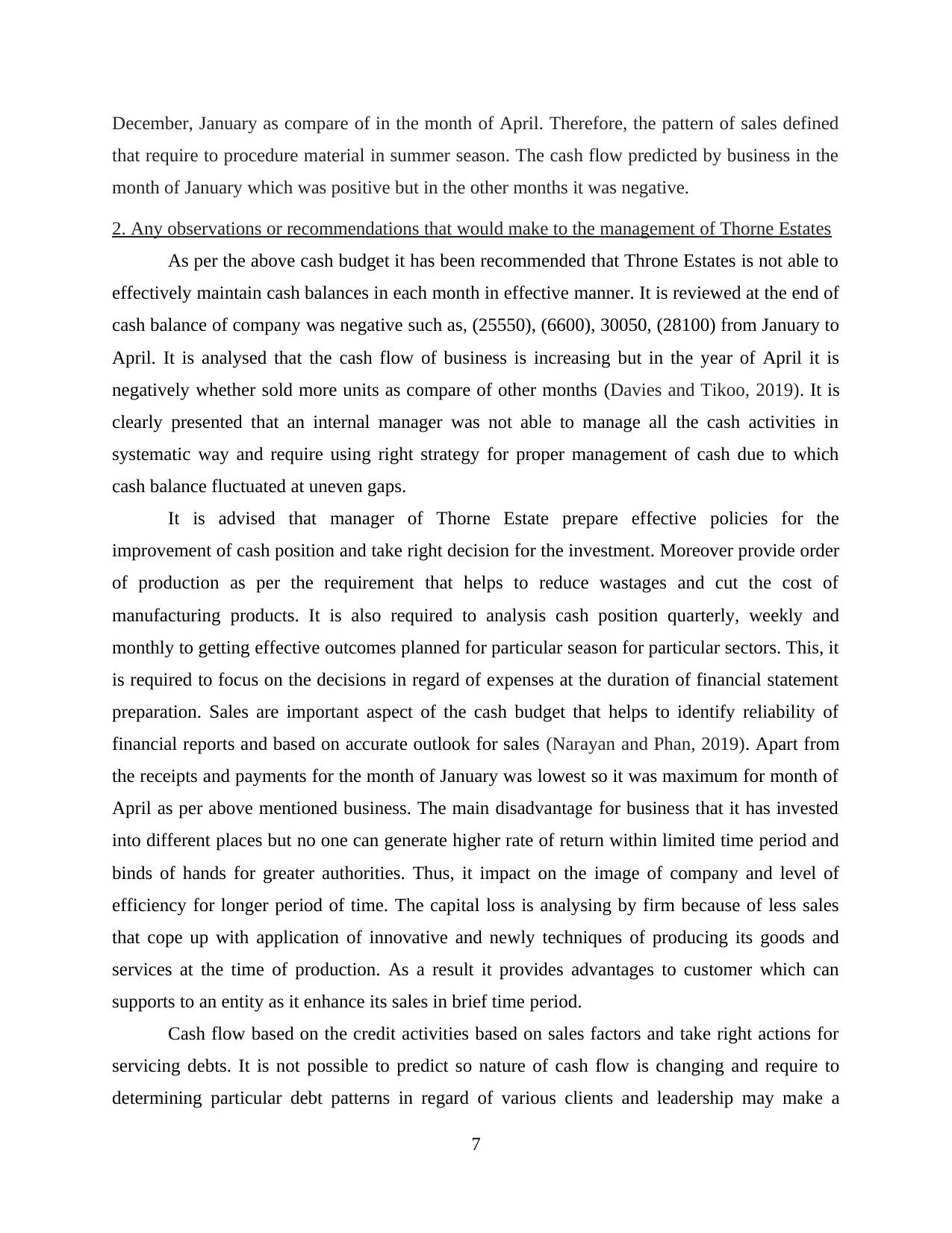
December, January as compare of in the month of April. Therefore, the pattern of sales defined
that require to procedure material in summer season. The cash flow predicted by business in the
month of January which was positive but in the other months it was negative.
2. Any observations or recommendations that would make to the management of Thorne Estates
As per the above cash budget it has been recommended that Throne Estates is not able to
effectively maintain cash balances in each month in effective manner. It is reviewed at the end of
cash balance of company was negative such as, (25550), (6600), 30050, (28100) from January to
April. It is analysed that the cash flow of business is increasing but in the year of April it is
negatively whether sold more units as compare of other months (Davies and Tikoo, 2019). It is
clearly presented that an internal manager was not able to manage all the cash activities in
systematic way and require using right strategy for proper management of cash due to which
cash balance fluctuated at uneven gaps.
It is advised that manager of Thorne Estate prepare effective policies for the
improvement of cash position and take right decision for the investment. Moreover provide order
of production as per the requirement that helps to reduce wastages and cut the cost of
manufacturing products. It is also required to analysis cash position quarterly, weekly and
monthly to getting effective outcomes planned for particular season for particular sectors. This, it
is required to focus on the decisions in regard of expenses at the duration of financial statement
preparation. Sales are important aspect of the cash budget that helps to identify reliability of
financial reports and based on accurate outlook for sales (Narayan and Phan, 2019). Apart from
the receipts and payments for the month of January was lowest so it was maximum for month of
April as per above mentioned business. The main disadvantage for business that it has invested
into different places but no one can generate higher rate of return within limited time period and
binds of hands for greater authorities. Thus, it impact on the image of company and level of
efficiency for longer period of time. The capital loss is analysing by firm because of less sales
that cope up with application of innovative and newly techniques of producing its goods and
services at the time of production. As a result it provides advantages to customer which can
supports to an entity as it enhance its sales in brief time period.
Cash flow based on the credit activities based on sales factors and take right actions for
servicing debts. It is not possible to predict so nature of cash flow is changing and require to
determining particular debt patterns in regard of various clients and leadership may make a
7
that require to procedure material in summer season. The cash flow predicted by business in the
month of January which was positive but in the other months it was negative.
2. Any observations or recommendations that would make to the management of Thorne Estates
As per the above cash budget it has been recommended that Throne Estates is not able to
effectively maintain cash balances in each month in effective manner. It is reviewed at the end of
cash balance of company was negative such as, (25550), (6600), 30050, (28100) from January to
April. It is analysed that the cash flow of business is increasing but in the year of April it is
negatively whether sold more units as compare of other months (Davies and Tikoo, 2019). It is
clearly presented that an internal manager was not able to manage all the cash activities in
systematic way and require using right strategy for proper management of cash due to which
cash balance fluctuated at uneven gaps.
It is advised that manager of Thorne Estate prepare effective policies for the
improvement of cash position and take right decision for the investment. Moreover provide order
of production as per the requirement that helps to reduce wastages and cut the cost of
manufacturing products. It is also required to analysis cash position quarterly, weekly and
monthly to getting effective outcomes planned for particular season for particular sectors. This, it
is required to focus on the decisions in regard of expenses at the duration of financial statement
preparation. Sales are important aspect of the cash budget that helps to identify reliability of
financial reports and based on accurate outlook for sales (Narayan and Phan, 2019). Apart from
the receipts and payments for the month of January was lowest so it was maximum for month of
April as per above mentioned business. The main disadvantage for business that it has invested
into different places but no one can generate higher rate of return within limited time period and
binds of hands for greater authorities. Thus, it impact on the image of company and level of
efficiency for longer period of time. The capital loss is analysing by firm because of less sales
that cope up with application of innovative and newly techniques of producing its goods and
services at the time of production. As a result it provides advantages to customer which can
supports to an entity as it enhance its sales in brief time period.
Cash flow based on the credit activities based on sales factors and take right actions for
servicing debts. It is not possible to predict so nature of cash flow is changing and require to
determining particular debt patterns in regard of various clients and leadership may make a
7
⊘ This is a preview!⊘
Do you want full access?
Subscribe today to unlock all pages.

Trusted by 1+ million students worldwide
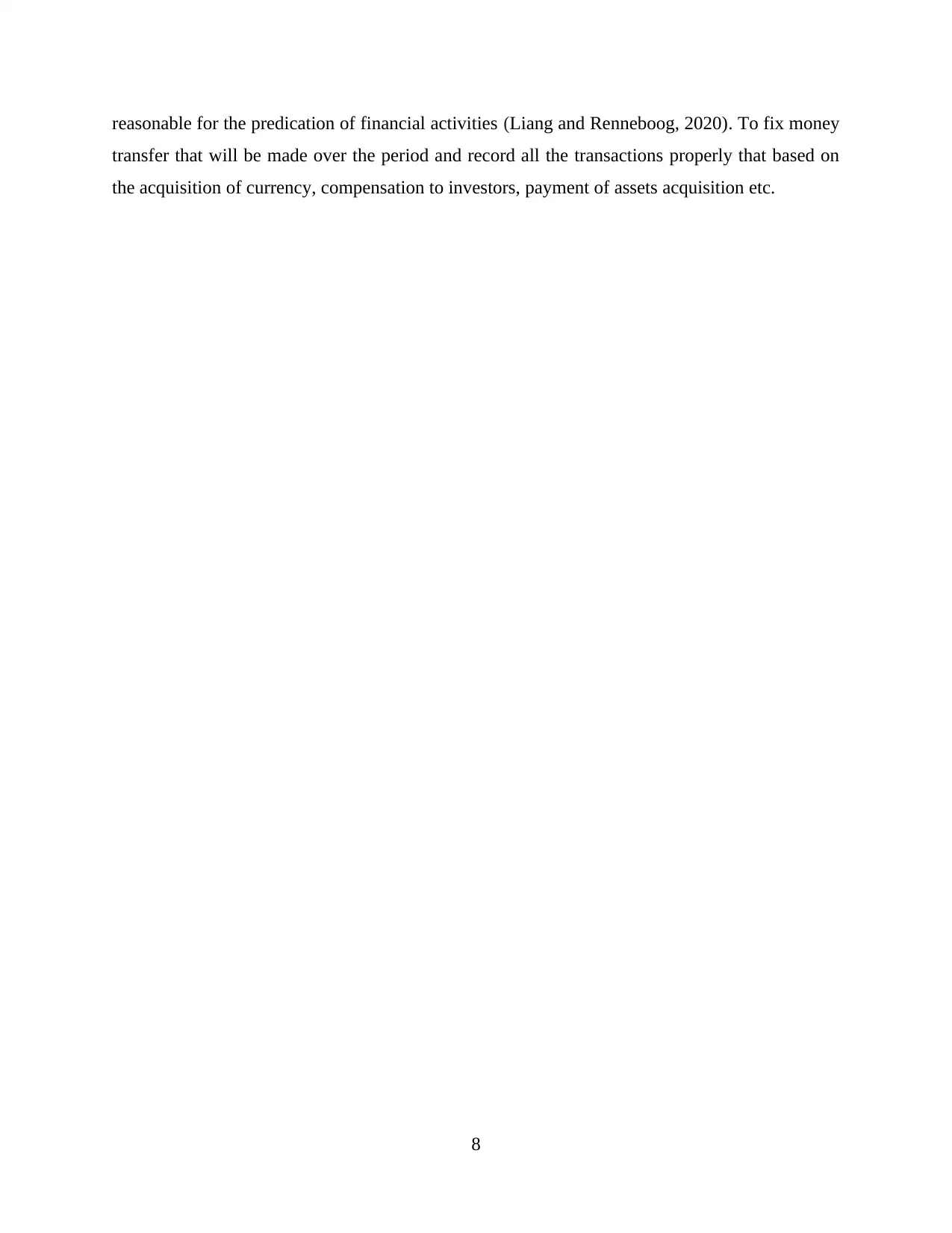
reasonable for the predication of financial activities (Liang and Renneboog, 2020). To fix money
transfer that will be made over the period and record all the transactions properly that based on
the acquisition of currency, compensation to investors, payment of assets acquisition etc.
8
transfer that will be made over the period and record all the transactions properly that based on
the acquisition of currency, compensation to investors, payment of assets acquisition etc.
8
Paraphrase This Document
Need a fresh take? Get an instant paraphrase of this document with our AI Paraphraser
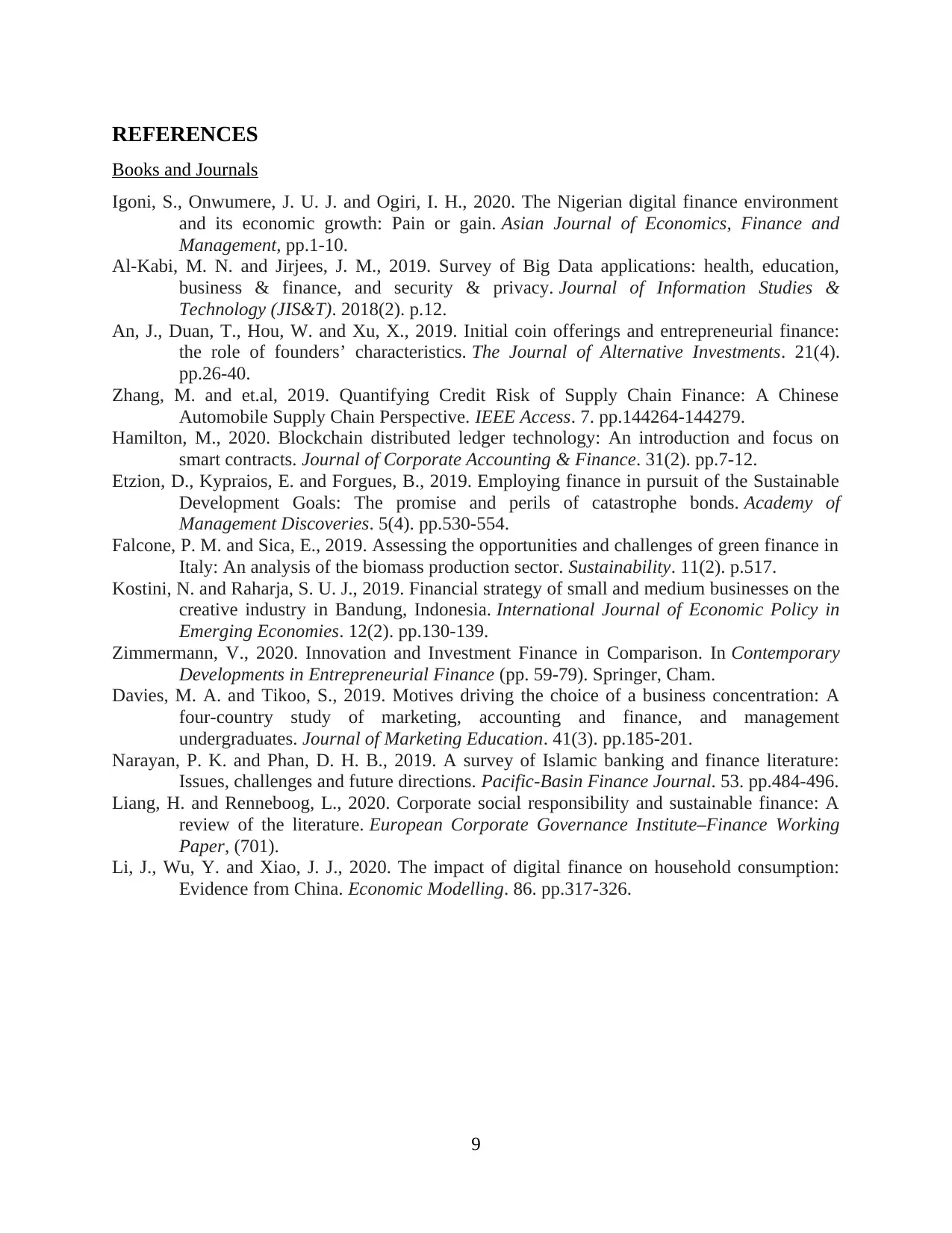
REFERENCES
Books and Journals
Igoni, S., Onwumere, J. U. J. and Ogiri, I. H., 2020. The Nigerian digital finance environment
and its economic growth: Pain or gain. Asian Journal of Economics, Finance and
Management, pp.1-10.
Al-Kabi, M. N. and Jirjees, J. M., 2019. Survey of Big Data applications: health, education,
business & finance, and security & privacy. Journal of Information Studies &
Technology (JIS&T). 2018(2). p.12.
An, J., Duan, T., Hou, W. and Xu, X., 2019. Initial coin offerings and entrepreneurial finance:
the role of founders’ characteristics. The Journal of Alternative Investments. 21(4).
pp.26-40.
Zhang, M. and et.al, 2019. Quantifying Credit Risk of Supply Chain Finance: A Chinese
Automobile Supply Chain Perspective. IEEE Access. 7. pp.144264-144279.
Hamilton, M., 2020. Blockchain distributed ledger technology: An introduction and focus on
smart contracts. Journal of Corporate Accounting & Finance. 31(2). pp.7-12.
Etzion, D., Kypraios, E. and Forgues, B., 2019. Employing finance in pursuit of the Sustainable
Development Goals: The promise and perils of catastrophe bonds. Academy of
Management Discoveries. 5(4). pp.530-554.
Falcone, P. M. and Sica, E., 2019. Assessing the opportunities and challenges of green finance in
Italy: An analysis of the biomass production sector. Sustainability. 11(2). p.517.
Kostini, N. and Raharja, S. U. J., 2019. Financial strategy of small and medium businesses on the
creative industry in Bandung, Indonesia. International Journal of Economic Policy in
Emerging Economies. 12(2). pp.130-139.
Zimmermann, V., 2020. Innovation and Investment Finance in Comparison. In Contemporary
Developments in Entrepreneurial Finance (pp. 59-79). Springer, Cham.
Davies, M. A. and Tikoo, S., 2019. Motives driving the choice of a business concentration: A
four-country study of marketing, accounting and finance, and management
undergraduates. Journal of Marketing Education. 41(3). pp.185-201.
Narayan, P. K. and Phan, D. H. B., 2019. A survey of Islamic banking and finance literature:
Issues, challenges and future directions. Pacific-Basin Finance Journal. 53. pp.484-496.
Liang, H. and Renneboog, L., 2020. Corporate social responsibility and sustainable finance: A
review of the literature. European Corporate Governance Institute–Finance Working
Paper, (701).
Li, J., Wu, Y. and Xiao, J. J., 2020. The impact of digital finance on household consumption:
Evidence from China. Economic Modelling. 86. pp.317-326.
9
Books and Journals
Igoni, S., Onwumere, J. U. J. and Ogiri, I. H., 2020. The Nigerian digital finance environment
and its economic growth: Pain or gain. Asian Journal of Economics, Finance and
Management, pp.1-10.
Al-Kabi, M. N. and Jirjees, J. M., 2019. Survey of Big Data applications: health, education,
business & finance, and security & privacy. Journal of Information Studies &
Technology (JIS&T). 2018(2). p.12.
An, J., Duan, T., Hou, W. and Xu, X., 2019. Initial coin offerings and entrepreneurial finance:
the role of founders’ characteristics. The Journal of Alternative Investments. 21(4).
pp.26-40.
Zhang, M. and et.al, 2019. Quantifying Credit Risk of Supply Chain Finance: A Chinese
Automobile Supply Chain Perspective. IEEE Access. 7. pp.144264-144279.
Hamilton, M., 2020. Blockchain distributed ledger technology: An introduction and focus on
smart contracts. Journal of Corporate Accounting & Finance. 31(2). pp.7-12.
Etzion, D., Kypraios, E. and Forgues, B., 2019. Employing finance in pursuit of the Sustainable
Development Goals: The promise and perils of catastrophe bonds. Academy of
Management Discoveries. 5(4). pp.530-554.
Falcone, P. M. and Sica, E., 2019. Assessing the opportunities and challenges of green finance in
Italy: An analysis of the biomass production sector. Sustainability. 11(2). p.517.
Kostini, N. and Raharja, S. U. J., 2019. Financial strategy of small and medium businesses on the
creative industry in Bandung, Indonesia. International Journal of Economic Policy in
Emerging Economies. 12(2). pp.130-139.
Zimmermann, V., 2020. Innovation and Investment Finance in Comparison. In Contemporary
Developments in Entrepreneurial Finance (pp. 59-79). Springer, Cham.
Davies, M. A. and Tikoo, S., 2019. Motives driving the choice of a business concentration: A
four-country study of marketing, accounting and finance, and management
undergraduates. Journal of Marketing Education. 41(3). pp.185-201.
Narayan, P. K. and Phan, D. H. B., 2019. A survey of Islamic banking and finance literature:
Issues, challenges and future directions. Pacific-Basin Finance Journal. 53. pp.484-496.
Liang, H. and Renneboog, L., 2020. Corporate social responsibility and sustainable finance: A
review of the literature. European Corporate Governance Institute–Finance Working
Paper, (701).
Li, J., Wu, Y. and Xiao, J. J., 2020. The impact of digital finance on household consumption:
Evidence from China. Economic Modelling. 86. pp.317-326.
9
1 out of 11
Related Documents
Your All-in-One AI-Powered Toolkit for Academic Success.
+13062052269
info@desklib.com
Available 24*7 on WhatsApp / Email
![[object Object]](/_next/static/media/star-bottom.7253800d.svg)
Unlock your academic potential
Copyright © 2020–2025 A2Z Services. All Rights Reserved. Developed and managed by ZUCOL.





